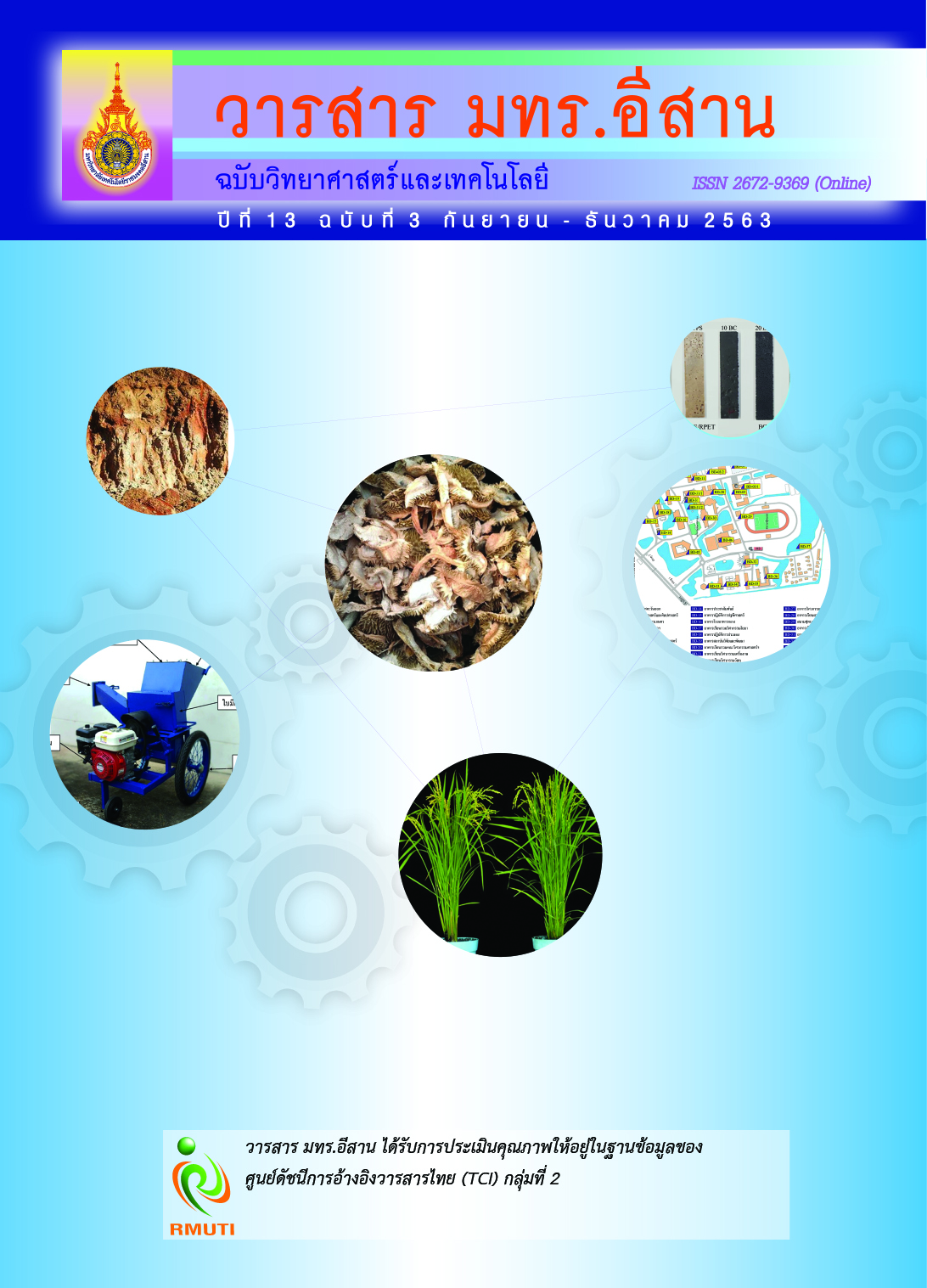A Drought Senescence NAC Gene, OMTN4, Confers Seed Development Defects in Rice
Main Article Content
Abstract
Transcription factors are important for gene regulation system in both animals and plants as these factors control various development processes. The NAC (NAM, ATAF, and CUC2) transcription factors play an important role in vital diverse processes and responses to stress. In rice, six NAC transcription factors targeted by miR164 were designated as OMTN1-6. Among them, OMTN4 (LOC_Os06g46270) plays a role in causing negative effects on drought resistance. Bioinformatic information revealed that OMTN4 is a rice NAC1/ANAC021 analog gene. In this study, we conducted the gain-of-function of OMTN4 overexpression and expression analysis. The results suggested that OMTN4 plays a negative role in inflorescence fertility. β-glucuronidase (GUS) histochemical study revealed that OMTN4 was expressed in leaf, seed husk, stigma, and root. OMTN4 expression profile was in correspondence with GUS histochemical result. Subcellular localization demonstrated that OMTN4 was localized in the nucleus, which was consistent with the other NAC TFs. Partial seed sterile phenotype and expression profile suggested that, other than the negative effect on drought stress, OMTN4 plays a negative role on inflorescence development.
Article Details
References
Sakuraba, Y., Piao, W., Lim, J. H., Han, S. H., Kim, Y. S., An, G., and Paek, N. C. (2015). Rice ONAC106 Inhibits Leaf Senescence and Increases Salt Tolerance and Tiller Angle. Plant Cell Physiol. Vol. 56, Issue 12, pp. 2325-2339. DOI: 10.1093/pcp/pcv144
Kim, J., Woo, H., Kim, J., Lim, P., Lee, I., Choi, S., Hwang, D., and Nam, H. (2009). Trifurcate Feed-Forward Regulation of Age-Dependent Cell Death Involving miR164 in Arabidopsis. Science. Vol. 323, Issue 5917, pp. 1053-1057. DOI: 10.1126/science.1166386
Li, Z., Peng, J., Wen, X., and Guo, H. (2013). ETHYLENE-INSENSITIVE3 Is a Senescence-Associated Gene That Accelerates Age-Dependent Leaf Senescence by Directly Repressing miR164 Transcription in Arabidopsis. Plant Cell. Vol. 25, pp. 3311-3328. DOI: 10.1105/tpc.113.113340
Laufs, P. (2009). How to Dissect a Leaf: A Role for the NAM/CUC3 Genes and the microRNA miR164. Comparative Biochemistry and Physiology - Part A Molecular & Integrative Physiology. Vol. 153, Issue. 2, p. S174. DOI: 10.1016/j.cbpa.2009.04.367
Fang, Y., Xie, K., and Xiong, L. (2014). Conserved miR164-targeted NAC Genes Negatively Regulate Drought Resistance in Rice. Journal of Experimental Botany. Vol. 65, Issue 8, pp. 2119-2135. DOI: 10.1093/jxb/eru072
Sunkar, R., Zhou, X., Zheng, Y., Zhang, W., and Zhu, J. (2008). Identification of Novel and Candidate miRNAs in Rice by High Throughput Sequencing. BMC Plant Biology. Vol. 8, DOI: 10.1186/1471-2229-8-25
Vialette-Guiraud, A., Chauvet, A., Gutierrez-Mazariegos, J., Eschstruth, A., Ratet, P., and Scutt, C. (2016). A Conserved Role for the NAM/miR164 Developmental Module Reveals a Common Mechanism Underlying Carpel Margin Fusion in Monocarpous and Syncarpous Eurosids. Frontiers in Plant Science. Vol. 6, DOI: 10.3389/fpls.2015.01239
Shang, H., Li, W., Zou, C., and Yuan, Y. (2013). Analyses of the NAC Transcription Factor Gene Family in Gossypium raimondii Ulbr.: Chromosomal Location, Structure, Phylogeny, and Expression Patterns. Journal Integration Plant Biology. Special Issue: Cotton Genetics and Genomics. Vol. 55, Issue 7, pp. 663-676. DOI: 10.1111/jipb.12085
Lin, Y. and Zhang, Q. (2005). Optimising the Tissue Culture Conditions for High Efficiency Transformation of Indica Rice. Plant Cell Report. Vol. 23, pp. 540-547. DOI: 10.1007/s00299-004-0843-6
Ye, R., Zhou, F., and Lin, Y. (2012). Two Novel Positive Cis-Regulatory Elements Involved in Green Tissue-Specific Promoter Activity in Rice (Oryza sativa L ssp.). Plant Cell Report. Vol. 31, pp. 1159-1172. DOI: 10.1007/s00299-012-1238-8
Yoo, S., Cho, Y., and Sheen, J. (2007). Arabidopsis Mesophyll Protoplasts: A Versatile Cell System for Transient Gene Expression Analysis. Nature Protocols. Vol. 2, No. 7, pp. 1565-1572. DOI: 10.1038/nprot.2007.199
Wu, W., Zheng, X., Lu, G., Zhong, Z., Gao, H., Chen, L., Wu, C., Wang, H., Wang, Q., Zhou, K., Wang, J., Wu, F., Zhang, X., Guo, X., Cheng, Z., Lei, C., Lin, Q., Jiang, L., Wang, H., Ge, S., and Wan, J. (2013) Association of Functional Nucleotide Polymorphisms at DTH2 with the Northward Expansion of Rice Cultivation in Asia. Proceedings of the National Academy of Sciences (PNAS). Vol. 110, pp. 2775-2780. DOI: 10.1073/pnas.1213962110
Chen, X., Cheng, J., Chen, L., Zhang, G., Huang, H., Zhang, Y., and Xu, L. (2016). Auxin-Independent NAC Pathway Acts in Response to Explant-Specific Wounding and Promotes Root Tip Emergence during de Novo Root Organogenesis in Arabidopsis. Plant Physiology. Vol. 170, pp. 2136-2145. DOI: 10.1104/pp.15.01733
Kim, J., Murphy, A., Baek, D., Lee, S., Yun, D., Bressan, R., and Narasimhan, M. (2011). YUCCA6 Over-expression Demonstrates Auxin Function in Delaying Leaf Senescence in Arabidopsis thaliana. Journal of Experimental Botany. Vol. 62, Issue 11, pp. 3981-3992. DOI: 10.1093/jxb/err094
Guo, H., Xie, Q., Fei, J., and Chua, N. (2005). MicroRNA Directs mRNA Cleavage of the Transcription Factor NAC1 to Downregulate Auxin Signals for Arabidopsis Lateral Root Development. The Plant Cell. Vol. 17, pp. 1376-1386. DOI: 10.1105/tpc.105.030841
Gomez-Gornez, L., Trapero-Mozos, A., Gomez, M., Rubio-Moraga, A., and Ahrazem, O. (2012). Identification and Possible Role of a MYB Transcription Factor From Saffron (Crocus sativus). Journal of Plant Physiology. Vol. 169, Issue 5, pp. 509-515. DOI: 10.1016/j.jplph.2011.11.021
Oda-Yamamizo, C., Mitsuda, N., Sakamoto, S., Ogawa, D., Ohme-Takagi, M., and Ohmiya, A. (2016). The NAC Transcription Factor ANAC046 is a Positive Regulator of Chlorophyll Degradation and Senescence in Arabidopsis Leaves. Scientifi c Report. Vol. 6, pp. 23609


